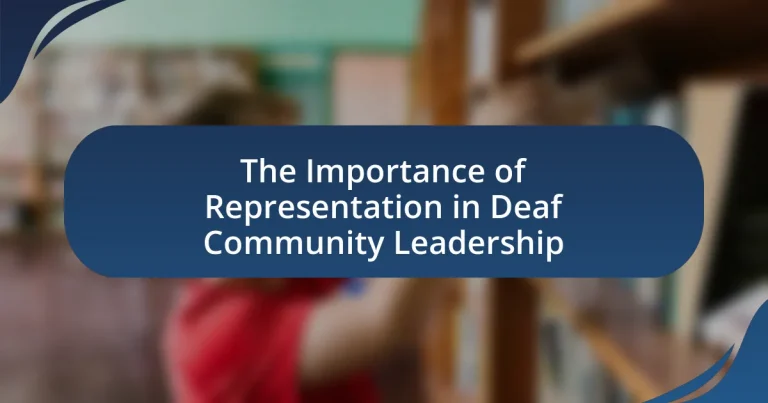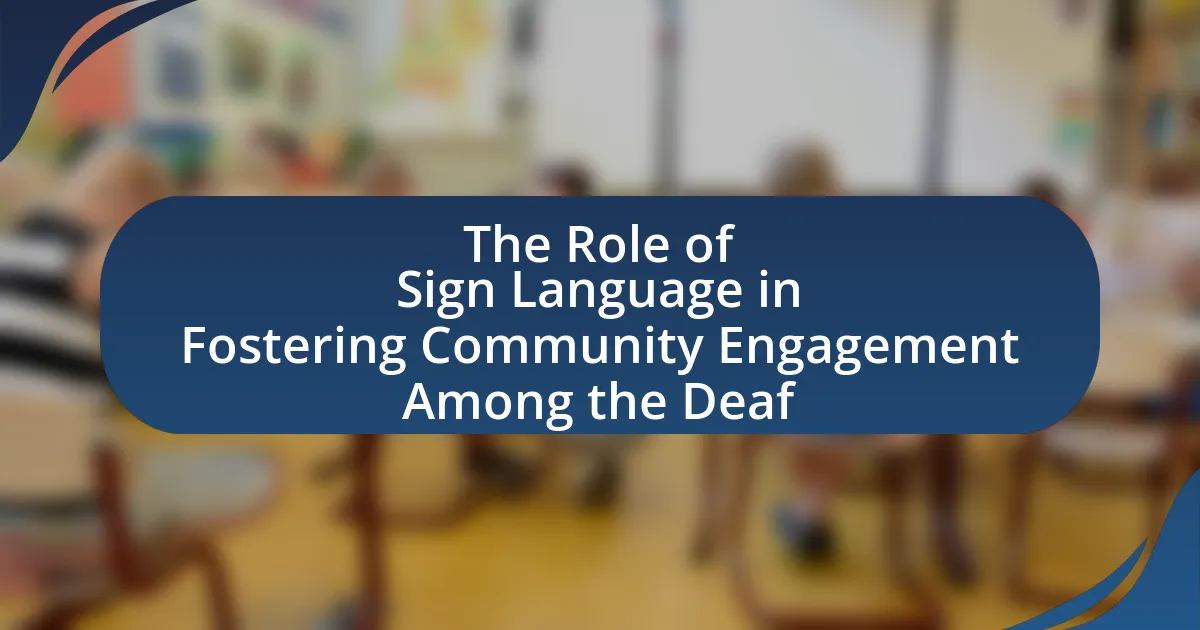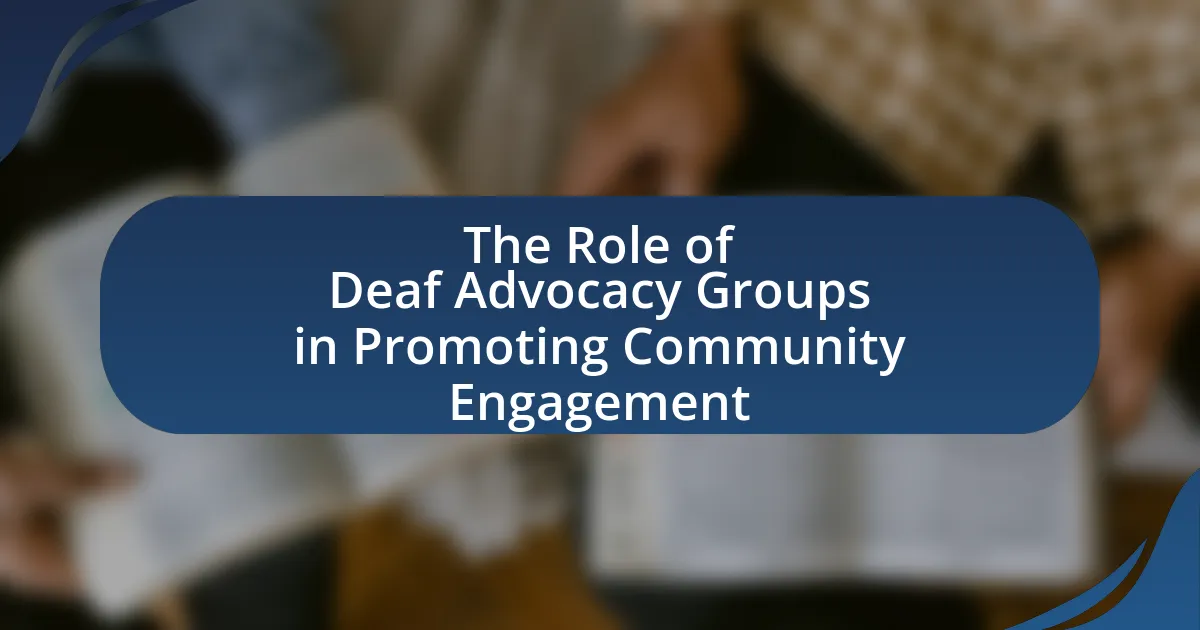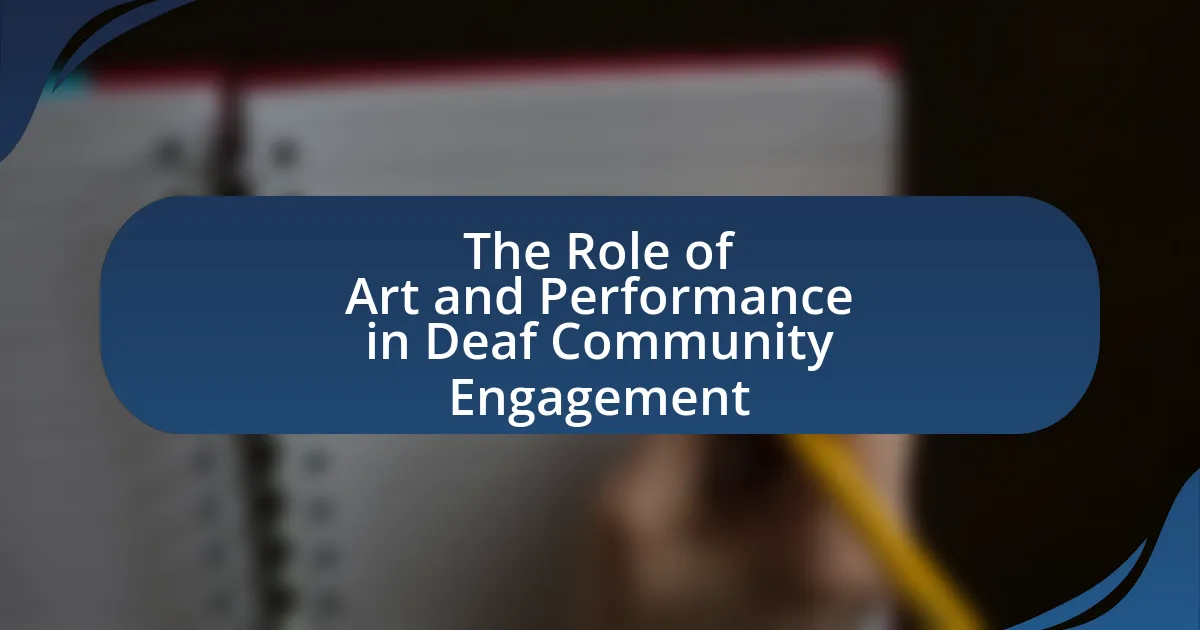The article focuses on the significance of representation in leadership within the Deaf community. It emphasizes that diverse leadership is essential for addressing the unique needs and perspectives of Deaf individuals, leading to improved advocacy, decision-making, and community engagement. Key topics include the impact of representation on policy-making, the barriers faced by Deaf individuals in attaining leadership roles, and the benefits of mentorship programs. The article also highlights how shared experiences among leaders enhance trust and effectiveness, ultimately fostering a sense of belonging and empowerment within the Deaf community.
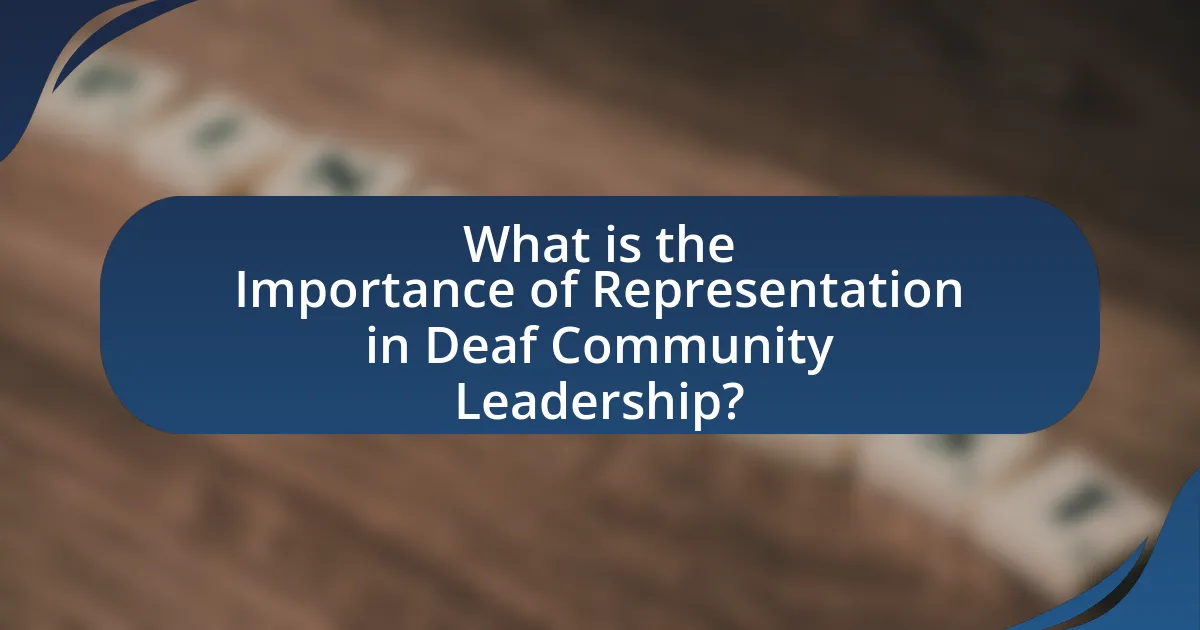
What is the Importance of Representation in Deaf Community Leadership?
Representation in Deaf community leadership is crucial for ensuring that the unique needs and perspectives of Deaf individuals are effectively addressed. When leaders within the Deaf community reflect its diversity, they foster inclusivity, enhance advocacy efforts, and promote culturally relevant policies. Research indicates that representation leads to better decision-making and outcomes, as leaders who share similar experiences can more accurately identify and respond to the challenges faced by their community. For instance, a study by the National Association of the Deaf highlights that Deaf leaders are more likely to prioritize issues such as access to education and employment opportunities, which are vital for the community’s advancement.
Why is representation crucial in leadership roles within the Deaf community?
Representation is crucial in leadership roles within the Deaf community because it ensures that the unique perspectives and needs of Deaf individuals are accurately reflected and addressed. When Deaf leaders are present, they can advocate for policies and practices that promote accessibility, inclusion, and equity, which are essential for the community’s empowerment. Research indicates that representation leads to better decision-making and outcomes, as leaders who share similar experiences can more effectively understand and respond to the challenges faced by their constituents. For instance, a study published in the Journal of Deaf Studies and Deaf Education highlights that Deaf-led organizations are more successful in creating programs that resonate with the community’s values and priorities.
How does representation impact decision-making in the Deaf community?
Representation significantly impacts decision-making in the Deaf community by ensuring that the perspectives and needs of Deaf individuals are included in leadership roles. When Deaf individuals hold positions of power, they can advocate for policies and practices that directly address the unique challenges faced by the community, such as access to education, healthcare, and employment opportunities. Research indicates that representation leads to better outcomes; for instance, a study published in the Journal of Deaf Studies and Deaf Education found that Deaf leaders are more likely to implement effective communication strategies and inclusive practices that benefit the community. This alignment between leadership and community needs fosters trust and encourages greater participation in decision-making processes among Deaf individuals.
What are the consequences of underrepresentation in leadership?
Underrepresentation in leadership leads to a lack of diverse perspectives, which can result in decisions that do not reflect the needs of all community members. This absence of varied viewpoints often perpetuates systemic inequalities and hinders innovation, as diverse leadership has been shown to enhance problem-solving and creativity. For instance, a study by McKinsey & Company found that companies with more diverse leadership teams are 33% more likely to outperform their peers in profitability. Additionally, underrepresentation can diminish trust and engagement within the community, as individuals may feel their voices are not heard or valued, ultimately affecting overall community cohesion and effectiveness.
How does representation influence community engagement and trust?
Representation significantly influences community engagement and trust by ensuring that diverse voices and perspectives are included in decision-making processes. When community members see individuals who reflect their identities and experiences in leadership roles, they are more likely to feel valued and understood, which fosters a sense of belonging. Research indicates that inclusive representation can lead to increased participation in community initiatives; for example, a study by the National Civic League found that communities with diverse leadership reported higher levels of civic engagement and trust in local institutions. This correlation suggests that representation not only enhances the legitimacy of leadership but also strengthens community bonds and encourages active involvement.
What role does shared experience play in leadership effectiveness?
Shared experience significantly enhances leadership effectiveness by fostering trust, understanding, and collaboration among team members. Leaders who share similar backgrounds or experiences with their followers can better empathize with their challenges and perspectives, leading to more effective communication and decision-making. Research indicates that leaders who have shared experiences with their teams are more likely to inspire loyalty and commitment, as seen in studies highlighting the positive correlation between shared identity and team cohesion. For instance, a study published in the Journal of Leadership Studies found that leaders who engage in shared experiences with their teams can improve overall performance and satisfaction, demonstrating the critical role of shared experience in effective leadership.
How can representation foster a sense of belonging in the Deaf community?
Representation fosters a sense of belonging in the Deaf community by validating identities and experiences through visible role models and leaders who share similar backgrounds. When Deaf individuals see themselves reflected in media, leadership positions, and community initiatives, it reinforces their sense of worth and belonging. Research indicates that representation can enhance self-esteem and community cohesion, as demonstrated in studies showing that Deaf individuals who engage with Deaf leaders report higher levels of community involvement and personal empowerment. This connection to representation not only affirms their cultural identity but also encourages active participation in community activities, thereby strengthening the overall sense of belonging within the Deaf community.
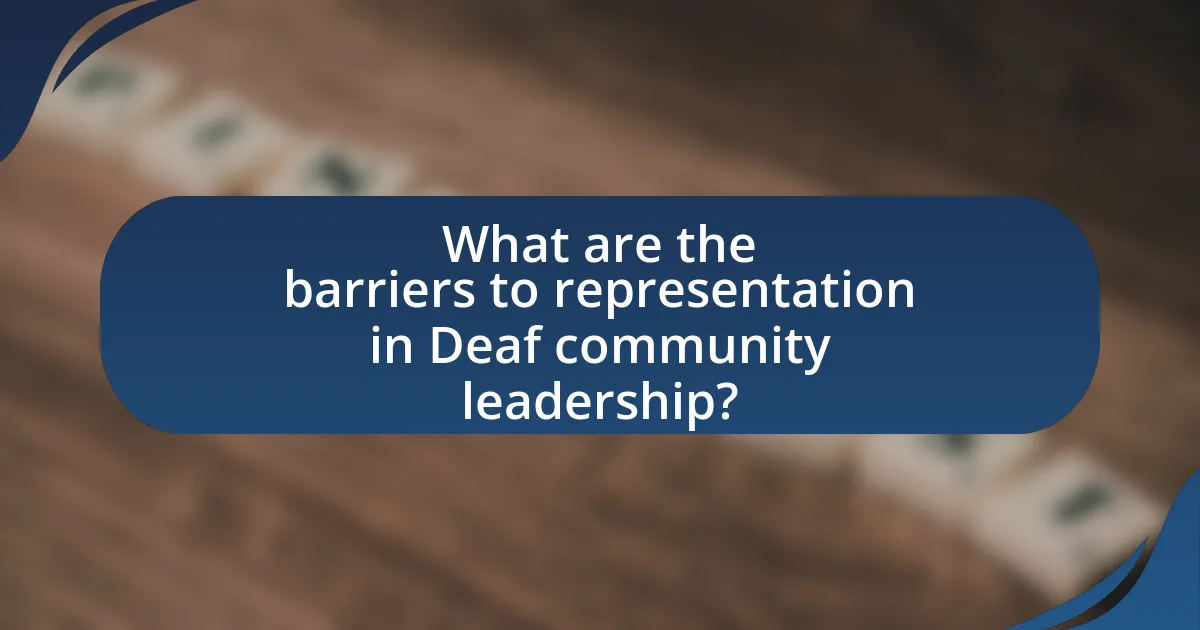
What are the barriers to representation in Deaf community leadership?
Barriers to representation in Deaf community leadership include limited access to resources, lack of visibility in mainstream leadership roles, and systemic discrimination. Limited access to resources, such as funding and training opportunities, restricts the ability of Deaf individuals to pursue leadership positions. Additionally, the underrepresentation of Deaf leaders in mainstream organizations perpetuates a cycle of invisibility, making it difficult for Deaf individuals to be recognized as viable leaders. Systemic discrimination, including biases against individuals with disabilities, further hinders their participation in leadership roles. According to a study by the National Deaf Center on Postsecondary Outcomes, only 48% of Deaf individuals feel they have equal opportunities in leadership compared to their hearing peers, highlighting the significant barriers they face.
What systemic challenges hinder Deaf individuals from attaining leadership positions?
Systemic challenges that hinder Deaf individuals from attaining leadership positions include communication barriers, lack of access to mentorship, and societal biases. Communication barriers arise from the predominance of spoken language in leadership contexts, which can marginalize Deaf individuals who primarily use sign language. Additionally, the absence of accessible mentorship programs limits opportunities for Deaf individuals to gain guidance and support from established leaders. Societal biases, including misconceptions about Deaf capabilities and leadership potential, further contribute to the underrepresentation of Deaf individuals in leadership roles. These challenges collectively create an environment that is not conducive to the advancement of Deaf individuals in leadership positions.
How do societal perceptions affect the representation of Deaf leaders?
Societal perceptions significantly influence the representation of Deaf leaders by shaping public attitudes and expectations regarding their capabilities. Negative stereotypes, such as viewing Deaf individuals as less competent or unable to lead, can limit opportunities for Deaf leaders in various sectors, including politics and business. Research indicates that when society holds misconceptions about Deaf individuals, it often results in fewer leadership roles being offered to them, as seen in studies highlighting the underrepresentation of Deaf individuals in leadership positions compared to their hearing counterparts. Furthermore, positive societal perceptions can enhance visibility and acceptance, leading to increased representation and support for Deaf leaders, as evidenced by initiatives that promote Deaf leadership in community organizations.
What role does access to resources play in leadership opportunities for the Deaf community?
Access to resources significantly enhances leadership opportunities for the Deaf community by providing essential tools, training, and networks necessary for effective leadership. When Deaf individuals have access to educational resources, mentorship programs, and funding, they are better equipped to develop leadership skills and pursue roles within their communities. For instance, research by the National Deaf Center on Postsecondary Outcomes indicates that access to quality education and support services directly correlates with increased leadership participation among Deaf individuals. This access not only fosters personal growth but also encourages representation in decision-making processes, ultimately leading to a more inclusive environment within the Deaf community.
How can these barriers be overcome to enhance representation?
Barriers to enhancing representation in Deaf community leadership can be overcome through targeted education, advocacy, and policy changes. Implementing comprehensive training programs that focus on leadership skills and cultural competency for Deaf individuals can empower them to take on leadership roles. Advocacy efforts should aim to raise awareness about the importance of Deaf representation in decision-making processes, which can lead to increased support from both the Deaf community and allies. Additionally, policies that promote inclusivity, such as ensuring access to sign language interpreters in public forums and leadership positions, can facilitate greater participation. Research indicates that organizations with diverse leadership are more effective, highlighting the necessity of representation for better outcomes in community initiatives.
What strategies can be implemented to support Deaf individuals in leadership roles?
To support Deaf individuals in leadership roles, organizations can implement strategies such as providing sign language interpreters during meetings, offering leadership training specifically designed for Deaf individuals, and fostering inclusive environments that prioritize accessibility. Research indicates that inclusive leadership training programs can enhance the skills and confidence of Deaf leaders, leading to better representation and decision-making within organizations. For example, the National Deaf Center on Postsecondary Outcomes highlights that mentorship programs connecting Deaf leaders with experienced professionals can significantly improve leadership opportunities and outcomes for Deaf individuals.
How can mentorship programs contribute to increasing representation?
Mentorship programs can significantly contribute to increasing representation by providing guidance and support to underrepresented individuals, particularly in leadership roles within the Deaf community. These programs facilitate skill development, networking opportunities, and access to resources that empower mentees to pursue leadership positions. For instance, a study by the National Mentoring Partnership found that mentored individuals are 55% more likely to enroll in college and 78% more likely to hold leadership positions, demonstrating the tangible impact of mentorship on career advancement. By fostering relationships between experienced leaders and emerging talents, mentorship programs help to create a more diverse and representative leadership landscape in the Deaf community.
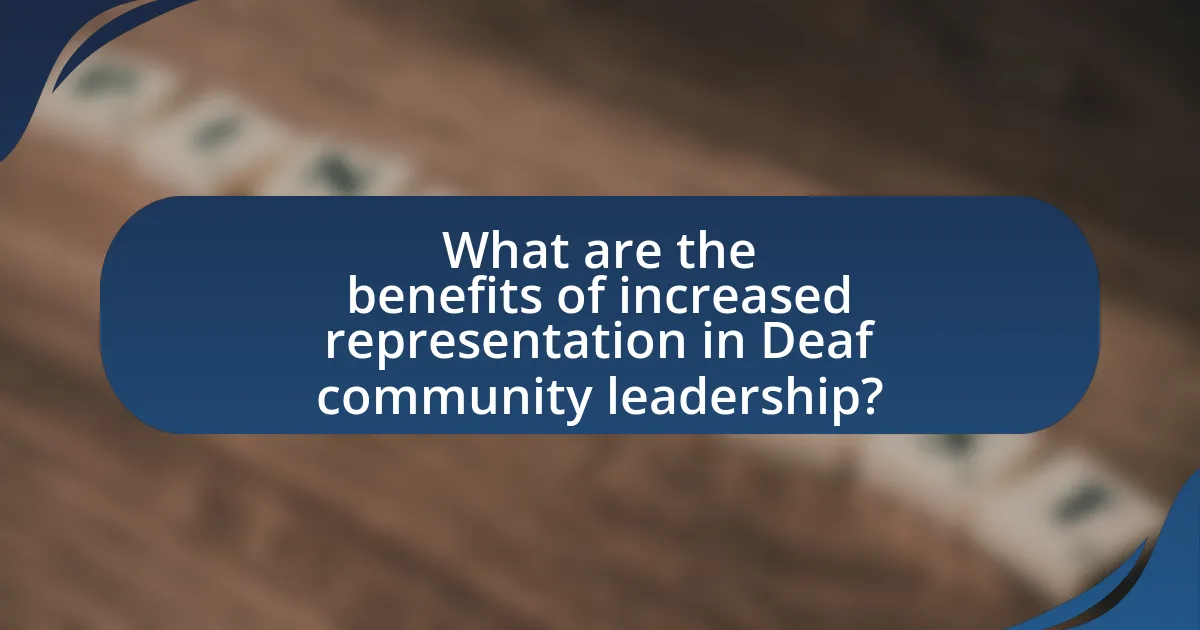
What are the benefits of increased representation in Deaf community leadership?
Increased representation in Deaf community leadership enhances advocacy, visibility, and empowerment for Deaf individuals. When leaders reflect the community’s diversity, they are more likely to address specific needs and concerns, leading to more effective policies and programs. Research indicates that diverse leadership can improve decision-making processes and foster innovation, as seen in studies showing that organizations with diverse leadership teams perform better in problem-solving and creativity. Furthermore, representation in leadership roles can inspire younger Deaf individuals, providing role models and encouraging greater participation in community activities and leadership opportunities.
How does diverse leadership improve community outcomes?
Diverse leadership improves community outcomes by fostering inclusive decision-making that reflects the varied needs and perspectives of all community members. When leadership is representative of the community’s diversity, it enhances trust and engagement among constituents, leading to more effective policies and programs. Research indicates that organizations with diverse leadership teams are 35% more likely to outperform their less diverse counterparts in terms of financial returns, as reported by McKinsey & Company in their 2020 Diversity Wins report. This correlation suggests that diverse leadership not only benefits organizational performance but also translates into better community services and initiatives that address the specific challenges faced by different groups within the community.
What positive changes have been observed in communities with representative leadership?
Communities with representative leadership have observed increased engagement and empowerment among members. This is evidenced by higher participation rates in community decision-making processes, which can lead to more tailored services and initiatives that meet the specific needs of the community. For instance, research conducted by the National Council on Disability in 2019 found that communities with diverse leadership reported improved trust and collaboration among members, resulting in enhanced social cohesion and support networks. Additionally, representative leadership has been linked to better advocacy for resources and policies that benefit the community, as leaders who share similar backgrounds and experiences are more attuned to the challenges faced by their constituents.
How does representation influence policy-making for the Deaf community?
Representation significantly influences policy-making for the Deaf community by ensuring that their unique needs and perspectives are included in legislative processes. When Deaf individuals hold positions of power or are actively involved in advocacy, they can effectively communicate the specific challenges faced by the community, such as access to education, healthcare, and employment opportunities. For instance, the establishment of the Americans with Disabilities Act in 1990 was heavily influenced by Deaf activists who highlighted the necessity for equal access and rights, demonstrating how representation can lead to impactful policy changes that directly benefit the community.
What skills and perspectives do Deaf leaders bring to the table?
Deaf leaders bring unique skills and perspectives that enhance community leadership, including strong advocacy for accessibility, cultural competency, and innovative problem-solving. Their lived experiences as members of the Deaf community enable them to identify and address barriers that others may overlook, fostering inclusivity. Research indicates that Deaf leaders often excel in visual communication and collaboration, which are essential for effective teamwork and engagement in diverse environments. Additionally, studies show that representation of Deaf individuals in leadership roles leads to better decision-making and policies that reflect the needs of the community, as evidenced by the increased visibility of Deaf culture and language in public discourse.
How does lived experience enhance leadership effectiveness?
Lived experience enhances leadership effectiveness by providing leaders with firsthand knowledge and understanding of the challenges faced by their communities. This deep insight allows leaders to make informed decisions that resonate with the needs and values of those they represent. For instance, leaders who have navigated the complexities of the Deaf community can advocate for policies and initiatives that genuinely address accessibility and inclusion. Research indicates that leaders with relevant lived experiences are more likely to foster trust and engagement among their constituents, as they can relate to their struggles and aspirations. This connection ultimately leads to more effective leadership outcomes, as evidenced by studies showing that diverse leadership teams, which include individuals with lived experiences, outperform homogeneous groups in problem-solving and innovation.
What unique insights do Deaf leaders provide in advocacy efforts?
Deaf leaders provide unique insights in advocacy efforts by drawing from their lived experiences and understanding of the challenges faced by the Deaf community. Their firsthand knowledge allows them to identify specific barriers, such as communication access and social stigma, that affect Deaf individuals. Research indicates that representation of Deaf leaders in advocacy roles leads to more effective policy changes, as they can articulate the community’s needs and priorities more accurately than non-Deaf advocates. For instance, studies show that Deaf-led organizations are more successful in securing funding and support for initiatives that directly benefit Deaf individuals, highlighting the importance of authentic representation in advocacy.
What practical steps can be taken to promote representation in Deaf leadership?
To promote representation in Deaf leadership, organizations should implement mentorship programs that connect emerging Deaf leaders with experienced professionals in leadership roles. These programs can facilitate skill development and provide networking opportunities, which are crucial for career advancement. Research indicates that mentorship significantly enhances leadership capabilities and confidence among underrepresented groups, including the Deaf community. Additionally, organizations should prioritize inclusive hiring practices that actively seek Deaf candidates for leadership positions, ensuring that job descriptions are accessible and outreach efforts target Deaf networks. This approach aligns with findings from the National Deaf Center, which emphasizes the importance of representation in fostering a more equitable environment.
How can community organizations actively support Deaf leadership initiatives?
Community organizations can actively support Deaf leadership initiatives by providing resources, training, and platforms for Deaf individuals to develop their leadership skills. For instance, organizations can offer workshops focused on leadership development specifically tailored for Deaf participants, ensuring accessibility through sign language interpreters and Deaf facilitators. Research indicates that inclusive leadership programs significantly enhance the confidence and capabilities of underrepresented groups, including the Deaf community. By fostering mentorship opportunities between established leaders and emerging Deaf leaders, organizations can create a supportive network that encourages growth and representation in leadership roles.
What role can education play in preparing future Deaf leaders?
Education plays a crucial role in preparing future Deaf leaders by equipping them with the necessary skills, knowledge, and confidence to advocate for their community. Through specialized programs that focus on leadership development, Deaf individuals gain insights into effective communication, advocacy strategies, and community engagement. Research indicates that educational initiatives tailored for Deaf students, such as those offered by institutions like Gallaudet University, foster a sense of identity and empowerment, which is essential for leadership. Furthermore, studies show that Deaf leaders who have received formal education are more likely to participate in civic activities and influence policy decisions, thereby enhancing representation within the Deaf community.
